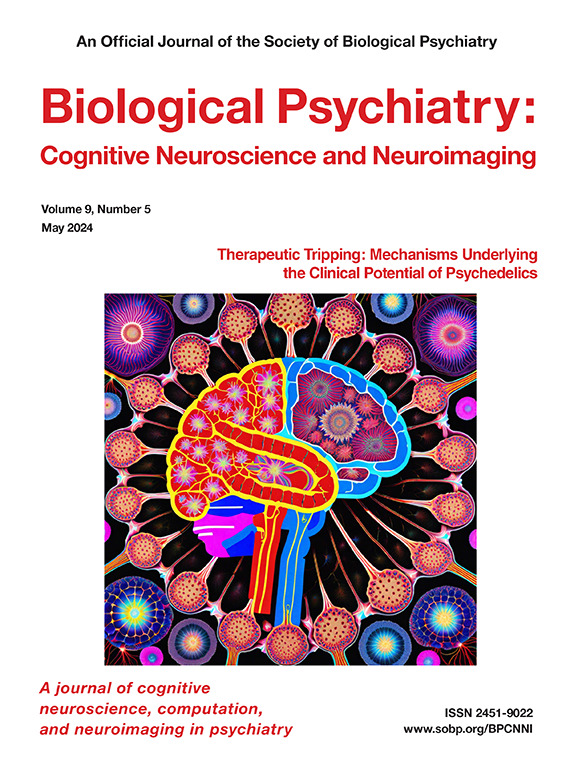Computational Phenotyping of Effort-Based Decision Making in Unmedicated Adults With Remitted Depression
IF 4.8
2区 医学
Q1 NEUROSCIENCES
Biological Psychiatry-Cognitive Neuroscience and Neuroimaging
Pub Date : 2025-06-01
DOI:10.1016/j.bpsc.2025.02.006
引用次数: 0
Abstract
Background
Reduced motivation is a core feature of major depressive disorder (MDD). Yet, the extent to which this deficit persists in remitted MDD (rMDD) remains unclear. Here, we examined effort-based decision making as one aspect of amotivation in rMDD using computational phenotyping to characterize decision-making processes and strategies.
Methods
Unmedicated adults with rMDD (n = 40) and healthy control (HC) participants (n = 68) completed the Effort Expenditure for Rewards Task. Repeated-measures analysis of variance and computational modeling—including hierarchical drift diffusion modeling and subjective value modeling—were applied to quantify decision-making dynamics in effort allocation across different reward magnitudes and probabilities.
Results
Relative to HC participants, participants with rMDD made overall fewer hard task choices, with an attenuated effect when accounting for anhedonia. However, specific to high reward, high probability conditions, participants with rMDD chose to expend effort more often than HC participants. This was supported by the drift diffusion model results revealing that participants with rMDD showed a drift rate biased toward selecting the easy task, counteracted by heightened influence of reward probability and magnitude. Probed with the subjective value model, this was not driven by group differences in decision strategies with respect to magnitude and probability information use.
Conclusions
Collectively, these findings suggest that while individuals with rMDD exhibit persistent motivational deficits, they retain a heightened sensitivity to high-value rewards, requiring more substantial or certain rewards to engage in effortful tasks. This pattern may reflect impairments in reward processing and effort-cost computations, contributing to motivational dysfunction. Targeting reward sensitivity and effort allocation could be valuable for interventions aimed at preventing MDD relapse.
未服药的抑郁症缓解成人中基于努力的决策的计算表现型。
背景:动机降低是重度抑郁障碍(MDD)的核心特征。然而,这种赤字在缓解型MDD (rMDD)中持续存在的程度仍不清楚。在这里,我们研究了基于努力的决策作为rMDD动机的一个方面,使用计算表型来表征决策过程和策略。方法:未用药的成年rMDD患者(N=40)和健康对照(hc, N=68)分别完成了奖励努力支出任务(efrt)。采用重复测量方差分析和计算模型(包括分层漂移扩散模型(DDM)和主观价值模型(SVM))来量化不同奖励大小和概率下努力分配的决策动态。结果:相对于hc, rMDD个体总体上较少做出困难的任务选择,考虑到快感缺乏症的影响减弱。然而,在高回报、高概率条件下,rMDD个体比hc更愿意付出努力。DDM结果也支持了这一点,rMDD个体表现出偏向于选择简单任务的漂移率,这被奖励概率和大小的增强影响所抵消。用支持向量机(SVM)进行探测,这不是由决策策略在量级和概率信息利用方面的群体差异驱动的。结论:总的来说,这些发现表明,虽然rMDD患者表现出持续的动机缺陷,但他们对高价值奖励保持高度敏感,需要更多的或特定的奖励来参与努力的任务。这种模式可能反映了奖励处理和努力成本计算的损伤,导致动机功能障碍。针对奖励敏感性和努力分配可能有价值的干预措施,旨在防止重度抑郁症复发。
本文章由计算机程序翻译,如有差异,请以英文原文为准。
求助全文
约1分钟内获得全文
求助全文
来源期刊

Biological Psychiatry-Cognitive Neuroscience and Neuroimaging
Neuroscience-Biological Psychiatry
CiteScore
10.40
自引率
1.70%
发文量
247
审稿时长
30 days
期刊介绍:
Biological Psychiatry: Cognitive Neuroscience and Neuroimaging is an official journal of the Society for Biological Psychiatry, whose purpose is to promote excellence in scientific research and education in fields that investigate the nature, causes, mechanisms, and treatments of disorders of thought, emotion, or behavior. In accord with this mission, this peer-reviewed, rapid-publication, international journal focuses on studies using the tools and constructs of cognitive neuroscience, including the full range of non-invasive neuroimaging and human extra- and intracranial physiological recording methodologies. It publishes both basic and clinical studies, including those that incorporate genetic data, pharmacological challenges, and computational modeling approaches. The journal publishes novel results of original research which represent an important new lead or significant impact on the field. Reviews and commentaries that focus on topics of current research and interest are also encouraged.
 求助内容:
求助内容: 应助结果提醒方式:
应助结果提醒方式:


